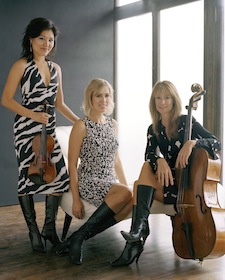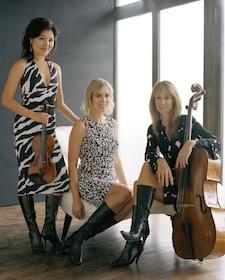
Of all human experiences that inspire art, nothing stirs the creativity and the desire for expression more than conflicts and strife. Unrequited love, Faustian bargain, poverty, and struggle for power have for centuries been subjects of all communicative art forms, from poetry, novels, and paintings to music. War-inspired music thus was the theme of Eroica Trio’s concert on a warm, sunny Sunday in Mill Valley.
It stands to reason, since wars have dominated the minds of many artists in much of the 20th century. With two world wars, and innumerable regional wars and conflicts that resulted in the death of hundreds of millions of people around the world, that bloody era gave birth to such devastating, yet powerful artworks as Picasso’s Guernica, Coppola’s Apocalypse Now, and Hemingway’s Farewell to Arms. Composers such as Debussy, Berg, Webern, and Prokofiev were no exception, having been provoked to write war-related music.
Maurice Ravel and Dmitri Shostakovich are two composers who were particularly influenced by their personal experience fighting in wars, and brought back the brutal imagery of the wars to embody in their music. Two instances of their war-inspired music, the Ravel Trio composed in 1914, and the Shostakovich Trio No. 2 (1944), formed the center of Eroica’s concert.
When considering how to perform works on such a subject, an artist faces a dilemma: how to present the matter, with a cerebral approach or with graphic violence? If violence in the conflict is graphically depicted, there may be a risk of numbing an audience’s senses, yet the cerebral approach may not reach the heart of the subject matter or touch the core of the emotions. The Trio chose the latter, a more abstract approach, with a fine silk veil that partially obscured the brutality beneath.
In the Ravel Trio, the result was the battle scene that seemed almost too serene and beautiful — not in the way that a lone flower among bodies scattered around a silent battlefield is beautiful, but more of how fog softens the scars on the terrain, and how the spring rain brings growing grass on the field. The unsettling 3+2+3 beats per measure of the “Zazpiak Bat” in the opening movement, or the alternating 5/4 and 7/4 times in the last movement, were like a steady clockwork, navigated stoically without the uneasy, heaving emotions underneath. The Trio seemed to glaze over the subtlest of the palpitations built in all phrases, and moved passively from one to the next, leaving the remains of the dead unnoticed.
Haunting Tones, Brutal Virtuosity
By contrast, in the Shostakovich Trio, the sarcasm and equivocations that are deeply integrated into the work leaped out vibrantly. The opening, which uses false harmonics in the cello, was frighteningly haunting and mournful. The vibratoless, stern colorlessness of the opening contrasted with the brutal virtuosity of the scherzo movement, and the sarcastic (or triumphant, depending on the perspective) “Workers’ Song” in G major created a violent contrast that was rather ironic, given the Stalinist regime of the time.
The Trio chose an abstract approach, with a fine silk veil that partially obscured the brutality beneath.
The largely biphonic piano part blended well with the strings, forming a cohesive quartet, and the range of colors and textures from clear articulations well depicted the barren, war-torn landscape of Eastern Europe, and the triumph of (and cynicism toward) the Communist Party. I may have pined for less and better-balanced vibrato in the B-flat minor duet section of the Largo movement, and for it to thus become a reflection of the opening of the first movement, but the multithreaded story full of equivocations was utterly convincing.
The concert opened with an uplifting trio by Spanish composer Gaspar Cassadó (1897–1966), with its vibrant Iberian colors. Here, the pianist, Erika Nickrenz, explored the most delicate and subtle colors in the depth of pianissimo at times, but punched blocky chords at other times. Meanwhile, violinist Susie Park and cellist Sara Sant’Ambrogio collaborated to illustrate the festive colors, full of Arabic influence and flamenco characters, in their glorious frenzy.
Closing the concert was an arrangement of Saint-Saëns’ “The Swan” from Carnival of the Animals. Perhaps the fleeting, warm spring sun outside had an effect on the concert over all, in spite of the program’s brutal components.

